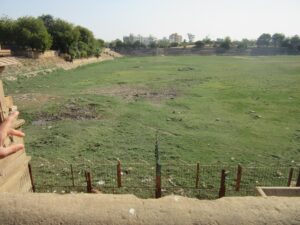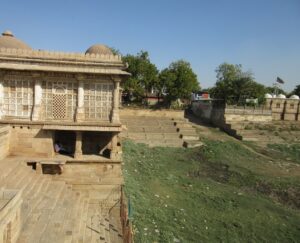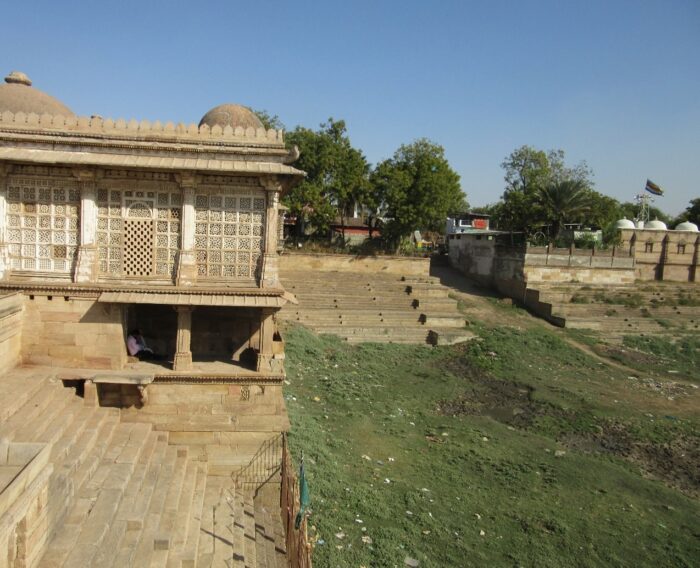By Amita Bhakta, Ahmedabad
In the rapidly growing city of Ahmedabad, adverts showcasing India’s Swachh Bharat, or clean India Mission, line the walls of underpass roads to demonstrate the ways in which India’s citizens are gradually gaining clean access to sanitation and water. But what of Ahmedabad’s past relationship with water and how has this changed? To understand this, I paid a visit to Sarkhej Roza, a mosque and tomb complex 7km towards the outskirts of the city.
Ahmedabad’s past cultural relationship with water
In a paper published by my CEPT University colleagues Gargi Mishra and Mona Iyer, along with Prasenjit Mishra, they refer to the water heritage of Sarkhej Roza as ‘dying’. Sarkhej Roza complex is formally recognised as an Ancient Heritage Site and Monument of National Importance under the Archaeological Survey of India. Sarkhej Roza is comprised of a man-made lake that was excavated in the 15th Century AD by Sultan Mahmud Beghada next to the Sarkhej Roza mosque and mausoleum of Shaikh Ahmed Khattu Ganj Bakhsh, a Sufi mystic and saint who advised Ahmed Shah I and became known for his teachings and gave the town of Sarkhej its name. As the saint reached Sarkhej on his travels, the village on the edge of Ahmedabad was inhabited by weavers and indigo dyers who were heavily reliant on the water from the nearby Makarba lake for their livelihoods. The monument itself was built over several stages after it was designed by two Persian brothers, Azam and Muazzam Khan. In later years, Sultan Mahmud Beghada, the grandson of Ahmed Shah I excavated a large water tank towards the south west of the mosque, ‘Ahmed-sar Tank’ which is now known as Sarkhej Lake, and used to receive water from Markaba lake. Spanning over 17 acres of land, the Sarkhej Lake was once seen as a source of sacred water, where locals once gathered to celebrate Sufi music as well as Hindu celebrations such as Janmashtami, the festival celebrating the birth of Lord Krishna. Under this premise, I was expecting to see a pool of water as the centrepiece of the mosque when I arrived, having known very little about it before I went. Yet, where there should be blue there was green. Where there should have been water, there was land, a carpet of grass covering a vast space within the grounds of the Roza. So I could not help but ask: if the built structure had been preserved, why was the body of water that used to define this monument no longer there?
I looked across the lake and saw very clearly the history of the ways in which the lake was there to serve the people of the local area. The steps down into the space which I could see along the side of the lake gave me an indication of the relationship it once had with people, who would step down into the water for spiritual cleansing. The vast scape seems to draw our eyes downwards and towards the centre. I was really struck by the topography of the undulating land. Although I am a human geographer by training rather than a physical geographer, something was telling me that over time the physical outlay of the lake changed as people interacted with it. But what were the catalysts, and why is it a challenge to sustain the heritage of Sarkhej Roza?


Modern-day challenges to India’s water heritage
In their paper, Mishra and Iyer’s reflections show clearly the very real challenges to the water bodies and systems of the past from modern day development. Ahmedabad’s urban sprawl has disturbed the natural flow of storm water in the area near to the Roza, as 50 per cent of the catchment has been overtaken by development that has occurred post-2000. Surface and ground water in the surrounding area has been polluted as access to infrastructure has expanded. Despite Ahmedabad being officially declared an ‘open defecation free’ city, the practice continues in the nearby area. So, the dried up Sarkhej lake reflects how India’s expanding cities are not as mindful of the natural aspects of heritage, and focussed on the built environment. This therefore begs the question, of how in an era of tackling climate change, can we preserve and care for the heritage of water and water infrastructure itself as a feature of growing cities? Piped water to households, schools and other buildings may be the talk of the day, but visiting Sarkhej Roza told me that it is India’s water sources of the past that also warrant further attention.
Sustaining water heritage: more than just policy
The layout of Sarkhej Roza’s lake tells a story of water as a communal good in the past, where there is plenty of space for gathering – in principle. In practice however, what I could see was a need for direct connection to the very people the lake once served, the local community, the worshippers at the mosque, in effect, the people of Sarkhej, to ensure that a route can be found once again to make the water theirs again. Linking the community back to their roots as dye-weavers could pave the way for them to work with the authorities to sustain Sarkhej Roza as a site of water infrastructure heritage for the future. Let’s look beyond pipes, taps and tanks, and back at the past as well, to sustain India’s waters old as well as new.
